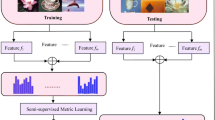Abstract
With the development of the times, people generate a huge amount of data every day, most of which are unlabeled data, but manual labeling needs a lot of time and effort, so unsupervised algorithms are being used more often. This paper proposes an unsupervised image clustering algorithm based on contrastive learning and K-nearest neighbors (CLKNN). CLKNN is trained in two steps, which are the representation learning step and the clustering step. Contrastive learning and K-nearest neighbors have a huge impact on CLKNN. In the representation learning step, firstly CLKNN processes the image by double data augmentation to get two different augmented images; then CLKNN uses double contrastive loss to extract the high-level feature information of the augmented images, maximizing the similarity of row space and maximizing the similarity of column space to ensure the invariance of information. In the clustering step, CLKNN finds the nearest neighbors of each image by K-nearest neighbors, then it maximizes the similarity between each image and its nearest neighbors to get the final result. To test the performance of CLKNN, the experiments are conducted on CIFAR-10, CIFAR-100 and STL-10 in this paper. From the final results, it is clear that CLKNN has better performance than other advanced algorithms.


Similar content being viewed by others
References
Kang G, Jiang L, Yang Y, Hauptmann AG (2019) Contrastive adaptation network for unsupervised domain adaptation. In: Proceedings of the IEEE Computer Society Conference on Computer Vision and Pattern Recognition, pp 4888–4897
Caron M, Bojanowski P, Joulin A, Douze M (2018) Deep clustering for unsupervised learning of visual features. Lect Notes Comput Sci 20:139–156
Zeng S, Zhang B, Zhang Y, Gou J (2020) Dual sparse learning via data augmentation for robust facial image classification. Int J Mach Learn Cybernet 11:1717–1734
Chen Z, Ding S, Hou H (2021) A novel self-attention deep subspace clustering. Int J Mach Learn Cybernet. https://doi.org/10.1007/s13042-021-01318-4
Wang W, Song H, Zhao S et al (2019) Learning unsupervised video object segmentation through visual attention. In: Proceedings of the IEEE Computer Society Conference on Computer Vision and Pattern Recognition, pp 3059–3069
Vo HV, Bach F, Cho M et al (2019) Unsupervised image matching and object discovery as optimization. In: Proceedings of the IEEE Computer Society Conference on Computer Vision and Pattern Recognition, pp 8279–8288
Fischer A, Igel C (2012) An introduction to restricted Boltzmann machines. Lect Notes Comput Sci 20:14–36
Rumelhart DE, Hinton GE, Williams RJ (1986) Learning representations by back-propagating errors. Nature 323(6088):533–536
Lecun Y, Bottou L, Bengio Y et al (1988) Gradient-based learning applied to document recognition. Proc IEEE Int Conf Comput Vis 86(11):533–536
Dosovitskiy A, Springenberg JT, Riedmiller M, Brox T (2014) Discriminative unsupervised feature learning with convolutional neural networks. Adv Neural Inf Process Syst 20:766–774
Hinton GE, Salakhutdinov RR (2006) Reducing the dimensionality of data with neural networks. Science 313(5786):504–507
Masci J, Meier U, Cireşan D et al (2011) Stacked convolutional auto-encoders for hierarchical feature extraction. In: The 21th international conference on artificial neural networks, pp 52–59
Goodfellow I, Pouget-Abadie J, Mirza M et al (2014) Generative adversarial nets. arXiv:1406.2601v1
Radford A, Metz L, Chintala S (2016) Unsupervised representation learning with deep convolutional generative adversarial networks. arxiv: 1511.06434
Xie J, Girshick R, Farhadi A (2016) Unsupervised deep embedding for clustering analysis. In: 33rd international conference on machine learning, vol 1, pp 740–749
Dizaji KG, Herandi A, Deng C et al (2017) Deep clustering via joint convolutional autoencoder embedding and relative entropy minimization. In: Proceedings of the IEEE international conference on computer vision, pp 5747–5756
Li F, Qiao H, Zhang B (2018) Discriminatively boosted image clustering with fully convolutional auto-encoders. Pattern Recogn 83:161–173
Yang J, Parikh D, Batra D (2016) Joint unsupervised learning of deep representations and image clusters. In: Proceedings of the IEEE computer society conference on computer vision and pattern recognition, pp 5147–5156
Caron M, Bojanowski P, Mairal J et al (2019) Unsupervised pre-training of image features on noncurated data. In: Proceedings of the IEEE international conference on computer vision, pp 2959–2968
Huang J, Gong S, Zhu X (2020) Deep semantic clustering by partition confidence maximisation. In: Proceedings of the IEEE Computer Society Conference on Computer Vision and Pattern Recognition, pp 8846–8855
Ji X, Vedaldi A, Henriques J (2019) Invariant information clustering for unsupervised image classification and segmentation. In: Proceedings of the IEEE international conference on computer vision, pp 9864–9873
Hadsell R, Chopra S, LeCun Y (2006) Dimensionality reduction by learning an invariant mapping. Proc IEEE Comput Soc Conf Comput Vis Pattern Recogn 2:1735–1742
Mnih A, Teh YW (2012) A fast and simple algorithm for training neural probabilistic language models. In: Proceedings of the 29th international conference on machine learning, vol 2, pp 1751–1758
Oord A van den, Li Y, Vinyals O (2018) Representation learning with contrastive predictive coding. arXiv:1807.03748
He K, Fan H, Wu Y, et al (2020) Momentum contrast for unsupervised visual representation learning. In: Proceedings of the IEEE Computer Society Conference on Computer Vision and Pattern Recognition, pp 9726–9735
Henaff OJ, Srinivas A, De Fauw J et al (2020) Data-efficient image recognition with contrastive predictive coding. In: 37th international conference on machine learning, pp 4130–4140
Chen T, Kornblith S, Norouzi M et al (2020) A simple framework for contrastive learning of visual representations. arXiv:2002.05709v3
Van Gansbeke W, Vandenhende S, Georgoulis S et al (2020) SCAN: learning to classify images without labels. Lect Notes Comput Sci 20:268–285
Acknowledgements
This work is supported by Hebei Provincial Department of education in 2021 provincial postgraduate demonstration course project construction under Grant KCJSX2021024.
Author information
Authors and Affiliations
Corresponding author
Additional information
Publisher's Note
Springer Nature remains neutral with regard to jurisdictional claims in published maps and institutional affiliations.
Rights and permissions
About this article
Cite this article
Zhang, X., Wang, S., Wu, Z. et al. Unsupervised image clustering algorithm based on contrastive learning and K-nearest neighbors. Int. J. Mach. Learn. & Cyber. 13, 2415–2423 (2022). https://doi.org/10.1007/s13042-022-01533-7
Received:
Accepted:
Published:
Issue Date:
DOI: https://doi.org/10.1007/s13042-022-01533-7




